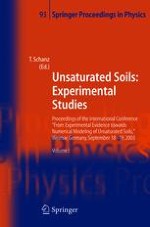These proceedings document the various papers delivered and partially presented at the International Conference “From experimental evidence towards numerical modeling of unsaturated soils,” which was held in Weimar (Germany) during 18-19 September 2003. The conference was organized under the auspices of the International Society of Soil Mechanics and Geotechnical Engineering (ISSMGE) and the National German G- technical Society (DGGT). The need to understand the behavior of unsaturated soils is becoming exclusively - sential for the geotechnical engineers and designers. In the last three decades many - searchers have made significant contribution to the understanding of the unsaturated soil mechanics. Nevertheless, application of the subject to variety of new problems still - quires our attention. This International conference is a mere attempt to unite researchers and engineers in geotechnical engineering and to discuss about the problems associated with the unsaturated soils. Doing so the objectives of these lecture notes are as follows: - to promote unsaturated soil mechanics for practical application, - to exchange experiences in experimental unsaturated soil mechanics and numerical modeling, - to discuss application of unsaturated soil mechanics to variety of problems. In other words, we could also name these two volumes as “From theory to daily pr- tice”. I would like to extend my deep sense of appreciation as the editor and the Head of the organizing committee, to many persons who have contributed either directly or indirectly to organize the International conference and to finalize these proceedings.
